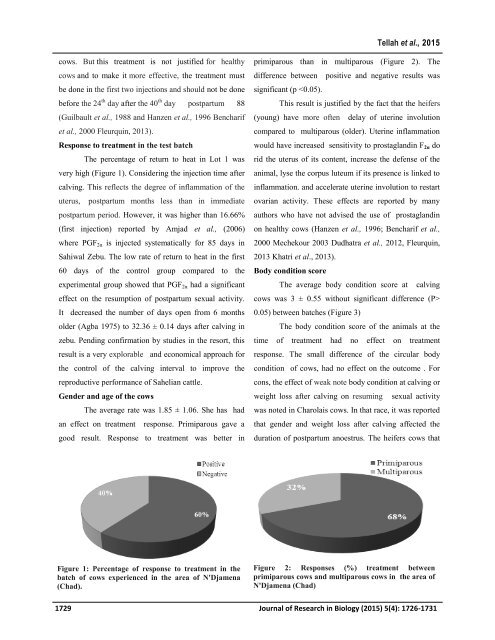Effect of the use of a singledose of prostaglandin F2α in cows after one month of calving
The objective of this study was to evaluate the effect of the systematic use of a single amount of the prostaglandin F2α after one month of calving on the renewal of sexual activity of beef at Chad. (Sixty five (65) cows of local breeds from N'Djamena urban area were selected and divided Into two groups: Forty-three (43) cows were treated with Prostaglandin F2α, one month after calving and 22 cows as witnesses. More than half (60.46%) of the cows answered the treatment and 39.54% did not react. The answer varied with the parity (68%) for the first half of the cows against 32% for the multiparous but the body weight at calving did not-have an effect. Only, the acceptance of overlapping was Retained for the detection of return in heat, which took place on an average of 2.36 ± 0.14 days after treatment. The treatment made it feasible to-have-one year interval between calving (first heat of 32.36 ± 0.14 days.) Heat thus obtained, can be used as reference to the stockbreeders to program the reproduction of their herd in order to have one year interval calving-calving closed. This test sample gave better Indication in first half of the cows while waiting for confirming it in the station.
The objective of this study was to evaluate the effect of the systematic use of a single amount of the prostaglandin F2α after one month of calving on the renewal of sexual activity of beef at Chad. (Sixty five (65) cows of local breeds from N'Djamena urban area were selected and divided Into two groups: Forty-three (43) cows were treated with Prostaglandin F2α, one month after calving and 22 cows as witnesses. More than half (60.46%) of the cows answered the treatment and 39.54% did not react. The answer varied with the parity (68%) for the first half of the cows against 32% for the multiparous but the body weight at calving did not-have an effect. Only, the acceptance of overlapping was Retained for the detection of return in heat, which took place on an average of 2.36 ± 0.14 days after treatment. The treatment made it feasible to-have-one year interval between calving (first heat of 32.36 ± 0.14 days.) Heat thus obtained, can be used as reference to the stockbreeders to program the reproduction of their herd in order to have one year interval calving-calving closed. This test sample gave better Indication in first half of the cows while waiting for confirming it in the station.
You also want an ePaper? Increase the reach of your titles
YUMPU automatically turns print PDFs into web optimized ePapers that Google loves.
Tellah et al., 2015<br />
<strong>cows</strong>. But this treatment is not justified for healthy<br />
<strong>cows</strong> and to make it more effective, <strong>the</strong> treatment must<br />
be d<strong>one</strong> <strong>in</strong> <strong>the</strong> first two <strong>in</strong>jections and should not be d<strong>one</strong><br />
before <strong>the</strong> 24 th day <strong>after</strong> <strong>the</strong> 40 th day postpartum 88<br />
(Guilbault et al., 1988 and Hanzen et al., 1996 Bencharif<br />
et al., 2000 Fleurqu<strong>in</strong>, 2013).<br />
Response to treatment <strong>in</strong> <strong>the</strong> test batch<br />
The percentage <strong>of</strong> return to heat <strong>in</strong> Lot 1 was<br />
very high (Figure 1). Consider<strong>in</strong>g <strong>the</strong> <strong>in</strong>jection time <strong>after</strong><br />
calv<strong>in</strong>g. This reflects <strong>the</strong> degree <strong>of</strong> <strong>in</strong>flammation <strong>of</strong> <strong>the</strong><br />
uterus, postpartum <strong>month</strong>s less than <strong>in</strong> immediate<br />
postpartum period. However, it was higher than 16.66%<br />
(first <strong>in</strong>jection) reported by Amjad et al., (2006)<br />
where PGF 2α is <strong>in</strong>jected systematically for 85 days <strong>in</strong><br />
Sahiwal Zebu. The low rate <strong>of</strong> return to heat <strong>in</strong> <strong>the</strong> first<br />
60 days <strong>of</strong> <strong>the</strong> control group compared to <strong>the</strong><br />
experimental group showed that PGF 2α had a significant<br />
effect on <strong>the</strong> resumption <strong>of</strong> postpartum sexual activity.<br />
It decreased <strong>the</strong> number <strong>of</strong> days open from 6 <strong>month</strong>s<br />
older (Agba 1975) to 32.36 ± 0.14 days <strong>after</strong> calv<strong>in</strong>g <strong>in</strong><br />
zebu. Pend<strong>in</strong>g confirmation by studies <strong>in</strong> <strong>the</strong> resort, this<br />
result is a very explorable and economical approach for<br />
<strong>the</strong> control <strong>of</strong> <strong>the</strong> calv<strong>in</strong>g <strong>in</strong>terval to improve <strong>the</strong><br />
reproductive performance <strong>of</strong> Sahelian cattle.<br />
Gender and age <strong>of</strong> <strong>the</strong> <strong>cows</strong><br />
The average rate was 1.85 ± 1.06. She has had<br />
an effect on treatment response. Primiparous gave a<br />
good result. Response to treatment was better <strong>in</strong><br />
primiparous than <strong>in</strong> multiparous (Figure 2). The<br />
difference between positive and negative results was<br />
significant (p <br />
0.05) between batches (Figure 3)<br />
The body condition score <strong>of</strong> <strong>the</strong> animals at <strong>the</strong><br />
time <strong>of</strong> treatment had no effect on treatment<br />
response. The small difference <strong>of</strong> <strong>the</strong> circular body<br />
condition <strong>of</strong> <strong>cows</strong>, had no effect on <strong>the</strong> outcome . For<br />
cons, <strong>the</strong> effect <strong>of</strong> weak note body condition at calv<strong>in</strong>g or<br />
weight loss <strong>after</strong> calv<strong>in</strong>g on resum<strong>in</strong>g sexual activity<br />
was noted <strong>in</strong> Charolais <strong>cows</strong>. In that race, it was reported<br />
that gender and weight loss <strong>after</strong> calv<strong>in</strong>g affected <strong>the</strong><br />
duration <strong>of</strong> postpartum anoestrus. The heifers <strong>cows</strong> that<br />
Figure 1: Percentage <strong>of</strong> response to treatment <strong>in</strong> <strong>the</strong><br />
batch <strong>of</strong> <strong>cows</strong> experienced <strong>in</strong> <strong>the</strong> area <strong>of</strong> N'Djamena<br />
(Chad).<br />
Figure 2: Responses (%) treatment between<br />
primiparous <strong>cows</strong> and multiparous <strong>cows</strong> <strong>in</strong> <strong>the</strong> area <strong>of</strong><br />
N'Djamena (Chad)<br />
1729 Journal <strong>of</strong> Research <strong>in</strong> Biology (2015) 5(4): 1726-1731
















